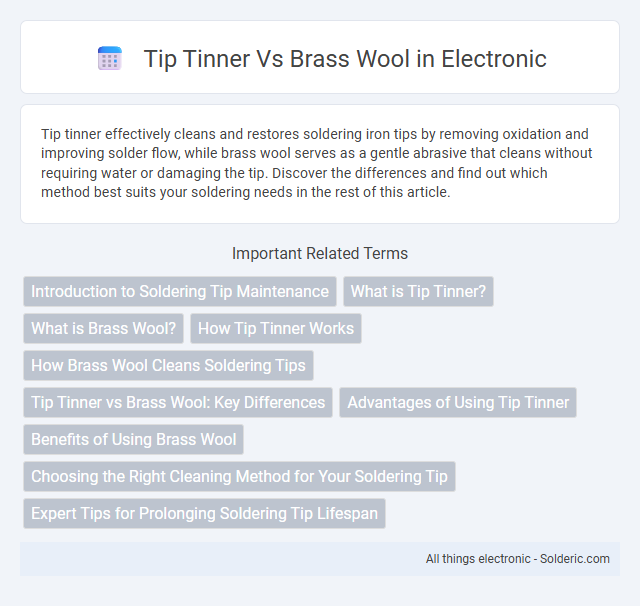Tip tinner effectively cleans and restores soldering iron tips by removing oxidation and improving solder flow, while brass wool serves as a gentle abrasive that cleans without requiring water or damaging the tip. Discover the differences and find out which method best suits your soldering needs in the rest of this article.
Comparison Table
| Feature | Tip Tinner | Brass Wool |
|---|---|---|
| Purpose | Restores oxidized soldering iron tips | Used as a cleaning pad for soldering iron tips |
| Material Composition | Contains flux and fine solder powder | Made of fine brass strands |
| Cleaning Method | Melts onto the tip to remove oxidation | Physically scrubs off residue and oxidation |
| Effectiveness | Re-tins and rejuvenates tip surface | Removes debris but does not re-tin |
| Durability | Used once per cleaning session | Reusable and long-lasting |
| Recommended Use | When tip is heavily oxidized or dull | Regular tip cleaning during soldering |
| Cost | Low cost, consumable | One-time purchase, reusable |
Introduction to Soldering Tip Maintenance
Soldering tip maintenance is crucial for efficient heat transfer and prolonged tool life, with tip tinner and brass wool being common options. Tip tinner rejuvenates the soldering tip by removing oxidation and adding fresh solder, ensuring optimal performance. Brass wool cleans the tip physically without abrasive damage, preserving the plating, making it ideal for quick, frequent maintenance during soldering tasks.
What is Tip Tinner?
Tip tinner is a specialized flux paste used to clean and rejuvenate soldering iron tips by removing oxidation and buildup, enhancing heat transfer efficiency. Composed mainly of powdered flux and metal particles such as tin and lead, it helps restore the tip's solderability without the need for aggressive mechanical abrasion. Unlike brass wool, which physically scrapes contaminants off the tip, tip tinner chemically cleans and re-tins the surface, prolonging the tip's lifespan and improving solder joint quality.
What is Brass Wool?
Brass wool consists of fine strands of brass, designed for gentle cleaning and polishing of delicate surfaces without causing rust or scratches. Unlike steel wool, brass wool is non-corrosive, making it ideal for maintaining your tools, musical instruments, and other metal items. Choosing brass wool ensures effective abrasion with minimal damage, perfect for precision tasks requiring a softer touch.
How Tip Tinner Works
Tip tinner works by chemically removing oxidation and buildup from soldering iron tips, restoring their ability to efficiently transfer heat during soldering. It contains flux combined with metal particles, typically tin and sometimes copper, which bond to the tip surface to rejuvenate the metal's cleanliness and wetting properties. Using tip tinner extends the life of your soldering iron tip by maintaining optimal thermal conductivity and preventing corrosion.
How Brass Wool Cleans Soldering Tips
Brass wool cleans soldering tips by effectively removing oxidation and residual solder without requiring flux, preserving tip integrity and extending its lifespan. Its abrasive yet non-corrosive properties allow for gentle scrubbing that prevents tip damage compared to rougher alternatives like tip tinner. When maintaining your soldering iron, brass wool offers a hygienic, reusable cleaning method that ensures consistent heat transfer and optimal soldering performance.
Tip Tinner vs Brass Wool: Key Differences
Tip tinner contains a flux and solder mixture designed to clean and re-tin soldering iron tips effectively, restoring their surface for better heat transfer. Brass wool acts mechanically by removing oxidation through abrasion without chemical flux, making it ideal for quick tip cleaning during soldering sessions. Choosing between them depends on whether you need chemical restoration with tip tinner or physical cleaning with brass wool to maintain your soldering tool's performance.
Advantages of Using Tip Tinner
Tip tinner offers superior cleaning efficiency by quickly removing oxidation and burnt flux residues from soldering iron tips, which enhances thermal conductivity and prolongs tip life. Its chemical formula actively revitalizes the tip surface, preventing tip degradation and reducing the need for frequent replacements. Compared to brass wool, tip tinner minimizes abrasive wear while maintaining optimal soldering performance and consistent heat transfer.
Benefits of Using Brass Wool
Brass wool offers superior durability and rust resistance compared to tip tinner, making it a long-lasting option for reclaiming solder tips. Its non-magnetic properties prevent damage to delicate electronic components while effectively removing oxidation and contaminants. Using brass wool helps maintain optimal soldering temperature, ensuring consistent and reliable solder joints for your electronics projects.
Choosing the Right Cleaning Method for Your Soldering Tip
Tip tinner and brass wool serve different purposes in soldering tip maintenance, with tip tinner used for restoring the tip's solderable surface and brass wool designed to remove oxidation without damaging the plating. You should choose tip tinner when your soldering tip is heavily oxidized or when re-tinning is needed to improve heat transfer efficiency. For regular cleaning during use, brass wool offers a gentle way to remove excess solder and contaminants while preserving the tip's longevity.
Expert Tips for Prolonging Soldering Tip Lifespan
Applying tip tinner regularly removes oxidation and re-tins the soldering tip, enhancing thermal conductivity and preventing premature wear. Brass wool effectively cleans the tip without causing abrasive damage, maintaining tip shape and prolonging lifespan compared to traditional wet sponges. Using tip tinner combined with brass wool cleaning ensures optimal soldering tip performance and durability in professional electronics work.
tip tinner vs brass wool Infographic

 solderic.com
solderic.com